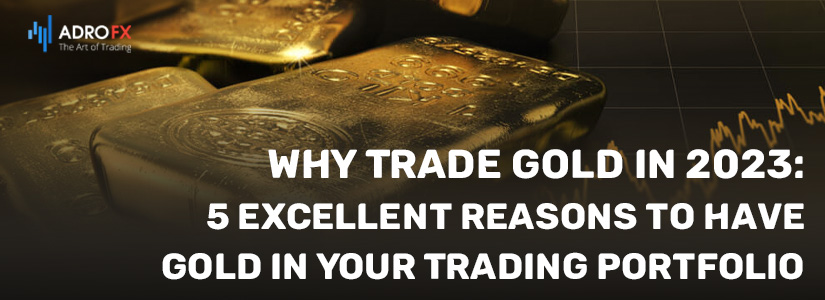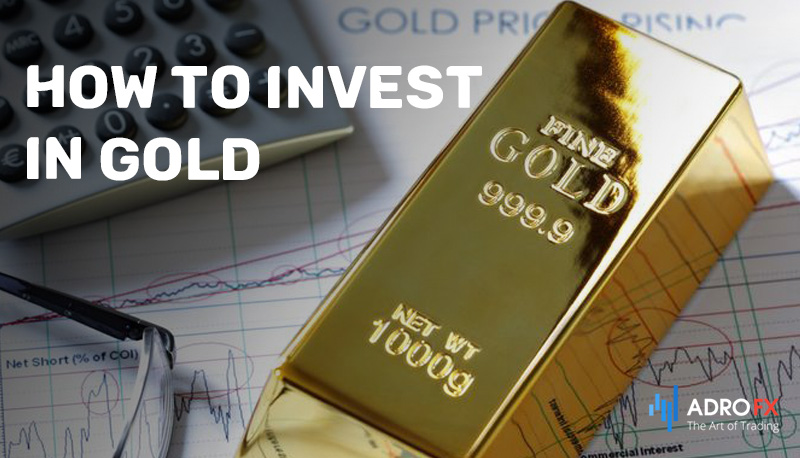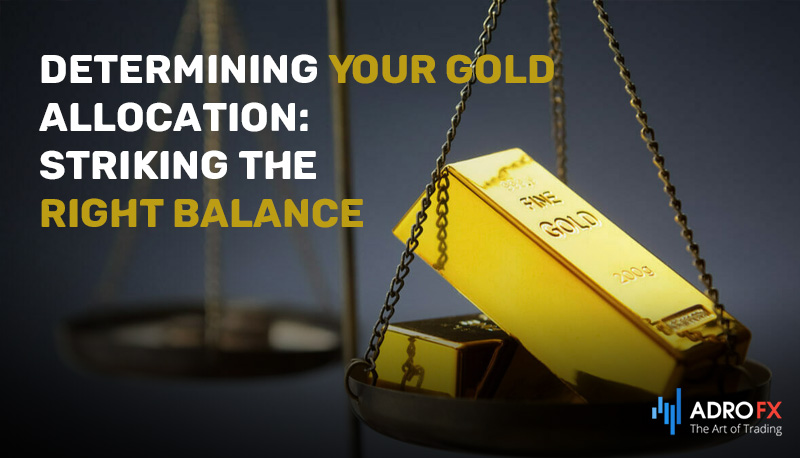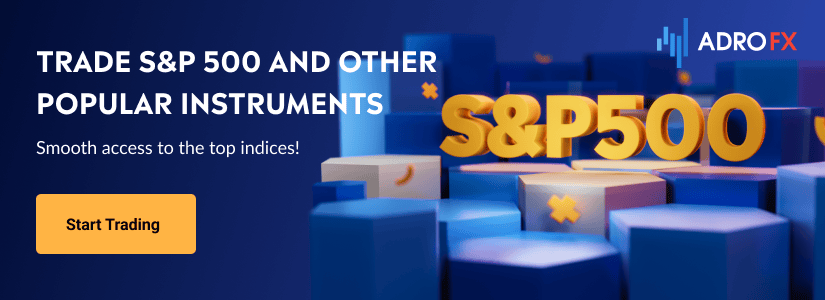Why Trade Gold in 2023: 5 Excellent Reasons to Have Gold in Your Trading Portfolio

In the world of financial markets, certain assets have consistently stood the test of time as reliable sources of value and security. Among these, gold has held a prominent position for centuries, earning its reputation as a safe haven and a store of wealth. As we navigate the year 2023, a landscape marked by evolving economic dynamics and global uncertainties, the allure of gold as a strategic addition to trading portfolios remains as strong as ever.
In this article, we delve into the compelling reasons why gold continues to be an attractive asset for traders and investors in the current market environment.From its historical resilience to economic turbulence to its role in diversification and risk management, we explore five excellent reasons why including gold in your trading portfolio could be a prudent and strategic decision. As we examine the unique qualities that make gold a standout asset, we shed light on how it can enhance the stability and earnings potential of your trading endeavors in the dynamic landscape of 2023.
Gold as Timeless Insurance: Beyond Commodity and Currency
Consider this: gold defies categorization as either a commodity or a currency; instead, it stands as a form of insurance. Let's delve into this concept. Imagine having $1000 today and opting to store it within your abode. Fast forward five years, and while you still possess the same $1000, its actual value will have significantly eroded. In essence, the goods you could purchase with that sum would be notably fewer than what you can acquire today - a principle referred to as the time value of currency.
Now, let's pivot to gold. Should you hold an ounce of gold today, half a decade from now, you'll still possess that identical ounce. The variable that alters is the dollar-denominated price of gold.
Following the cessation of the gold standard, many voices have contended that gold is merely a commoditized relic. Their stance rests on the issues elucidated above. However, this perspective overlooks the historical role of gold.
In ancient times, gold reigned as the primary medium of exchange across numerous nations. Given gold's unwieldy nature, countries transitioned to currency for its convenience in printing and handling.
At present, most governments safeguard substantial gold reserves. The likes of the US' Fort Knox house gold valued at over $180 billion, contributing to a national treasury that boasts gold holdings totaling $11 trillion. Numerous nations likewise hold significant gold reserves.
With this groundwork laid, we approach the crux of our article: Why should a trader hold an interest in this illustrious metal?

5 Compelling Reasons to Invest
In the realm of investments, few assets carry the enduring allure and significance of gold. As we navigate the complex landscape of today's financial markets, several compelling reasons stand out for including gold in your investment strategy:
1. Diversification
Gold has long been regarded as a diversification tool. Its performance often exhibits a low correlation with traditional financial assets like stocks and bonds. This unique characteristic can help mitigate overall portfolio risk and enhance stability, particularly during periods of market turbulence.
2. Increasing Demand
The demand for gold continues to surge, driven by various factors. Beyond its historical allure, gold finds application in industries such as electronics and technology. Additionally, growing consumer markets in emerging economies contribute to rising demand.
3. Supply Problems
Discovering and mining new gold deposits becomes progressively challenging. This supply-side constraint could potentially support gold prices, as demand outpaces available supply.
4. Geopolitical Uncertainty
In times of geopolitical turmoil and uncertainty, gold often shines as a safe haven asset. Its value tends to be appreciated when global events create market instability, making it a valuable component of a risk-averse investment strategy.
5. Inflation Hedge
Gold has historically served as a hedge against inflation. When traditional currencies lose value due to rising inflation rates, the inherent value of gold tends to remain more stable, preserving purchasing power.
Each of these factors underscores the enduring relevance of gold as a strategic investment. Whether as a means of diversification, a safeguard against geopolitical upheaval, or a hedge against inflation, gold's timeless appeal continues to resonate in the contemporary investment landscape.

How to Invest in Gold
Investing in gold can be an effective way to diversify your portfolio, hedge against inflation, and preserve wealth. Here are several methods to consider when looking to invest in gold:
Physical Gold
- Gold Coins and Bars: Purchasing physical gold coins and bars is a common way to invest in gold. These can be bought from reputable dealers and stored in a secure location.
- Jewelry: While primarily ornamental, gold jewelry can also serve as an investment. However, it's important to consider factors like craftsmanship and design when assessing its value.
Gold Exchange-Traded Funds (ETFs)
ETFs are investment funds traded on stock exchanges. Gold ETFs hold physical gold bullion or track the performance of gold prices. Investing in ETFs provides exposure to gold without the need for physical storage.
Gold Mutual Funds
Mutual funds pool finances from multiple investors to invest in a diversified portfolio of assets, including gold-related investments such as mining company stocks, ETFs, and futures contracts.
Gold Mining Stocks
Investing in gold mining companies' stocks can offer exposure to potential returns from gold production. However, these stocks can be influenced by factors beyond the price of gold, such as company management and operational issues.
Gold Futures and Options
Trading gold futures contracts or options on gold allows investors to speculate on the future price of gold. However, these are complex instruments and carry higher risk and leverage.
Gold Royalty and Streaming Companies
These companies provide financing to gold mining companies in exchange for a portion of future production at a fixed price. Investing in them offers exposure to potential gold price increases and reduced operational risk compared to owning mining stocks.
Digital Gold
Digital platforms allow you to invest in fractional ownership of physical gold, which is securely stored in vaults. This provides ease of investment and eliminates the need for physical storage.
Before investing in gold, consider your investment goals, risk tolerance, and preferred method of exposure. It's essential to conduct thorough research, seek advice from financial professionals, and choose reputable sources for purchasing and storing gold. Remember that like any investment, the value of gold can fluctuate, and past performance is not indicative of future results.
Why Trade Gold Contracts for Difference (CFDs)
Contracts for Difference (CFDs) are derivatives that allow traders to speculate on the price movements of various assets, including gold, without owning the underlying asset. With CFDs, you can benefit from both rising and falling gold prices.
Among the benefits of trading gold CFDs, we can name the following:
- Leverage: CFDs offer leverage, meaning you can control a larger position with a smaller amount of capital. While leverage can amplify gains, it also increases the potential for losses.
- No Ownership of Physical Gold: When trading gold CFDs, you don't own the actual gold; instead, you're entering into a contract with a broker based on the price movement of gold.
- Short Selling: CFDs allow you to engage in short selling, where you can benefit from a decline in gold prices by selling before buying, aiming to buy back at a lower price.
- Margin and Risk Management: Due to the leverage involved, managing margin requirements and risk is crucial when trading gold CFDs. Sudden price movements can lead to significant losses if not managed properly.
- Market Access: CFDs provide access to a wide range of markets and assets, allowing traders to diversify their trading strategies beyond physical gold investments.
- Costs: Trading CFDs typically involves costs such as spreads, commissions, and overnight financing fees. It's important to consider these costs when evaluating the potential return of your trades.
Trading gold through CFDs can be appealing due to the flexibility and potential for return in both rising and falling markets. However, CFD trading involves a high level of risk, and it's crucial to have a strong understanding of the market, risk management, and trading strategies before engaging in CFD trading.

Determining Your Gold Allocation: Striking the Right Balance
The question of how much of your portfolio should be dedicated to gold investments is a common inquiry among investors. Achieving a well-rounded portfolio involves a strategic allocation across various key assets.
While the 60/40 approach is widely known - allocating 40% to bonds and 60% to stocks - it may not always be the most optimal choice. Instead, we propose an allocation strategy that emphasizes diversity. Allocating around 80% of your funds to a balanced assortment of stocks, encompassing both value and growth stocks, lays a robust foundation. Complementary to this, your portfolio should encompass other asset types, including bonds, commodities, and select cryptocurrencies.
Within this framework, an allocation of approximately 10% to gold can be considered prudent. This allocation strikes a balance between benefiting from gold's potential as a safe haven and safeguarding against overexposure to any specific asset, including gold. In navigating the complexities of investment, maintaining a diversified approach is key to attaining long-term stability and growth.
Conclusion
As we navigate the intricate financial landscape of 2023, gold remains a steadfast and compelling asset for traders and investors. Its historical significance and five key attributes - diversification, rising demand, supply constraints, geopolitical stability, and inflation protection - underscore its enduring appeal.
From physical gold to digital platforms, numerous investment avenues cater to different preferences and risk tolerances. However, a balanced approach that allocates around 10% of a portfolio to gold emerges as a prudent strategy, offering stability and mitigating risks.
In the ever-changing world of finance, gold's time-tested resilience and unique qualities position it as a valuable addition to trading portfolios. It serves as a beacon of stability and opportunity, offering a timeless way to navigate the complexities of the market.
About AdroFx
Established in 2018, AdroFx is known for its high technology and its ability to deliver high-quality brokerage services in more than 200 countries around the world. AdroFx makes every effort to keep its customers satisfied and to meet all the trading needs of any trader. With the five types of trading accounts, we have all it takes to fit any traders` needs and styles. The company provides access to 115+ trading instruments, including currencies, metals, stocks, and cryptocurrencies, which make it possible to make the most out of trading on the financial markets. Considering all the above, AdroFx is the perfect variant for anyone who doesn't settle for less than the best.









